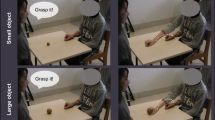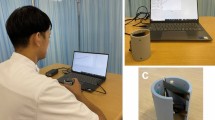Abstract
This study explores the effects of visual condition and target size during four reach-to-grasp tasks between autistic children and healthy controls. Twenty children with autism and 20 healthy controls participated in the study. Qualisys motion capture system and kinematic measures were used to record movement. Autistic group showed significantly longer movement time, larger normalized jerk score, more movement unit than controls, especially in non-visual feedback and small target blocks. Autistic group also showed significantly larger maximal grip aperture and normalized maximal grip aperture in visual feedback condition than controls. Autistic children demonstrate motor coordination problems and also depend on more visual cuing in high accuracy tasks. Autistic children develop other compensatory skills while performing tasks.






Similar content being viewed by others
References
Alberts, J. L., Saling, M., Adler, C. H., & Stelmach, G. E. (2000). Disruptions in the reach-to-grasp actions of Parkinson’s patients. Experimental Brain Research, 134(3), 353–362.
Baranek, G. T., David, F. J., Poe, M. D., Stone, W. L., & Watson, L. R. (2006). Sensory experiences questionnaire: Discriminating sensory features in young children with autism, developmental delays, and typical development. [Research Support, N.I.H., Extramural Research Support, Non-U.S. Gov’t]. Journal of Child Psychology and Psychiatry, 47(6), 591–601. doi:10.1111/j.1469-7610.2005.01546.x.
Baranek, G. T., Parham, L. D., & Bodfish, J. W. (2005). Sensory and motor features in autism: assessment and intervention. In F. R. Volkmar, R. Paul, A. Klin, & D. Cohen (Eds.), Handbook of autism and pervasive developmental disorders (pp. 831–857). Hoboken, NJ: John Wiley.
Chang, J. J., Wu, T. I., Wu, W. L., & Su, F. C. (2005). Kinematical measure for spastic reaching in children with cerebral palsy. Clinical Biomechanics, 20(4), 381–388.
Day, B. L., Thompson, P. D., Harding, A. E., & Marsden, C. D. (1998). Influence of vision on upper limb reaching movements in patients with cerebellar ataxia: Comparative study. Brain, 121, 357–372.
Desmurget, M., Grea, H., Grethe, J. S., Prablanc, C., Alexander, G. E., & Grafton, S. T. (2001). Functional anatomy of nonvisual feedback loops during reaching: a positron emission tomography study. [Clinical Trial Research Support, U.S. Gov’t, P.H.S.]. Journal of Neuroscience, 21(8), 2919–2928.
Dowd, A. M., McGinley, J. L., Taffe, J. R., & Rinehart, N. J. (2012). Do planning and visual integration difficulties underpin motor dysfunction in autism? A kinematic study of young children with autism. [Research Support, Non-U.S. Gov’t]. Journal of Autism & Developmental Disorders, 42(8), 1539–1548. doi:10.1007/s10803-011-1385-8.
Eigsti, I. M., & Shapiro, T. (2003). A systems neuroscience approach to autism: Biological, cognitive, and clinical perspectives. [Review]. Mental Retardation & Developmental Disabilities Research Reviews, 9(3), 205–215.
Fasoli, S. E., Trombly, C. A., Tickle-Degnen, L., & Verfaellie, M. H. (2002). Effect of instructions on functional reach in persons with and without cerebrovascular accident. American Journal of Occupational Therapy, 56(4), 380–390.
Forti, S., Valli, A., Perego, P., Nobile, M., Crippa, A., & Massimo, M. (2011). Motor planning and control in autism. A kinematic analysis of preschool children. Research in Autism Spectrum Disorders, 5, 834–842.
Fuentes, C. T., Mostofsky, S. H., & Bastian, A. J. (2011). No proprioceptive deficits in autism despite movement-related sensory and execution impairments. [Research Support, N.I.H., Extramural Research Support, Non-U.S. Gov’t]. Journal of Autism & Developmental Disorders, 41(10), 1352–1361. doi:10.1007/s10803-010-1161-1.
Ghaziuddin, M., & Butler, E. (1998). Clumsiness in autism and Asperger syndrome: A further report. Journal of Intellectual Disability Research, 42, 43–48.
Glazebrook, C. M., Elliott, D., & Lyons, J. (2006). A kinematic analysis of how young adults with and without autism plan and control goal-directed movements. [Research Support, Non-U.S. Gov’t]. Motor Control, 10(3), 244–264.
Glazebrook, C., Gonzalez, D., Hansen, S., & Elliott, D. (2009). The role of vision for online control of manual aiming movements in persons with autism spectrum disorders. [Comparative Study Research Support, Non-U.S. Gov’t]. Autism, 13(4), 411–433. doi:10.1177/1362361309105659.
Green, D., Charman, T., Pickles, A., Chandler, S., Loucas, T., Simonoff, E., et al. (2009). Impairment in movement skills of children with autistic spectrum disorders. Developmental Medicine and Child Neurology, 51(4), 311–316. doi:10.1111/j.1469-8749.2008.03242.x.
Huebner, R. A., & Lane, S. J. (2001). Neuropsychological findings, etiology and implications for autism. In R. A. Huebner (Ed.), Autism: A sensorimotor approach to management (pp. 61–99). Austin: ProEd.
Jakobson, L. S., & Goodale, M. A. (1991). Factors affecting higher-order movement planning: A kinematic analysis of human prehension. Experimental Brain Research, 86(1), 199–208.
Karl, J. M., Sacrey, L. A., Doan, J. B., & Whishaw, I. Q. (2012). Hand shaping using hapsis resembles visually guided hand shaping. [Research Support, Non-U.S. Gov’t]. Experimental Brain Research, 219(1), 59–74. doi:10.1007/s00221-012-3067-y.
Kern, J. K., Trivedi, M. H., Garver, C. R., Grannemann, B. D., Andrews, A. A., Savla, J. S., et al. (2006). The pattern of sensory processing abnormalities in autism. [Research Support, Non-U.S. Gov’t]. Autism, 10(5), 480–494. doi:10.1177/1362361306066564.
Kientz, M. A., & Dunn, W. (1997). A comparison of the performance of children with and without autism on the sensory profile. [Research Support, U.S. Gov’t, P.H.S.]. The American Journal of Occupational Therapy, 51(7), 530–537.
Kuhtz-Buschbeck, J. P., Stolze, H., Boczek-Funcke, A., Johnk, K., Heinrichs, H., & Illert, M. (1998a). Kinematic analysis of prehension movements in children. Behavioural Brain Research, 93(1–2), 131–141.
Kuhtz-Buschbeck, J. P., Stolze, H., Johnk, K., Boczek-Funcke, A., & Illert, M. (1998b). Development of prehension movements in children: A kinematic study. Experimental Brain Research, 122(4), 424–432.
Leekam, S. R., Nieto, C., Libby, S. J., Wing, L., & Gould, J. (2007). Describing the sensory abnormalities of children and adults with autism. [Research Support, Non-U.S. Gov’t]. Journal of Autism & Developmental Disorders, 37(5), 894–910. doi:10.1007/s10803-006-0218-7.
Liu, T. (2013). Sensory processing and motor skill performance in elementary school children with autism spectrum disorder. Perceptual & Motor Skills, 116(1), 197–209.
Manjiviona, J., & Prior, M. (1995). Comparison of Asperger syndrome and high-functioning autistic children on a test of motor impairment. Journal of Autism & Developmental Disorders, 25(1), 23–39.
Mari, M., Castiello, U., Marks, D., Marraffa, C., & Prior, M. (2003). The reach-to-grasp movement in children with autism spectrum disorder. Philosophical Transactions of the Royal Society of London–Series B: Biological Sciences, 358(1430), 393–403.
Marteniuk, R. G., MacKenzie, C. L., Jeannerod, M., Athenes, S., & Dugas, C. (1987). Constraints on human arm movement trajectories. Canadian Journal of Psychology, 41(3), 365–378.
Minshew, N. J., Sung, K., Jones, B. L., & Furman, J. M. (2004). Underdevelopment of the postural control system in autism. Neurology, 63(11), 2056–2061.
Miyahara, M., Tsujii, M., Hori, M., Nakanishi, K., Kageyama, H., & Sugiyama, T. (1997). Brief report: motor incoordination in children with Asperger syndrome and learning disabilities. Journal of Autism & Developmental Disorders, 27(5), 595–603.
Molloy, C. A., Dietrich, K. N., & Bhattacharya, A. (2003). Postural stability in children with autism spectrum disorder. Journal of Autism and Developmental Disorders, 33(6), 643–652.
Rand, M. K., Shimansky, Y., Stelmach, G. E., Bracha, V., & Bloedel, J. R. (2000). Effects of accuracy constraints on reach-to-grasp movements in cerebellar patients. [Research Support, Non-U.S. Gov’t Research Support, U.S. Gov’t, P.H.S.]. Experimental Brain Research, 135(2), 179–188.
Rinehart, N. J., Bellgrove, M. A., Tonge, B. J., Brereton, A. V., Howells-Rankin, D., & Bradshaw, J. L. (2006). An examination of movement kinematics in young people with high-functioning autism and Asperger’s disorder: Further evidence for a motor planning deficit. [Research Support, Non-U.S. Gov’t]. Journal of Autism & Developmental Disorders, 36(6), 757–767. doi:10.1007/s10803-006-0118-x.
Shumway-Cook, A., & Woollacott, M. H. (2001). Motor control: Theory and practical applications. Baltimore MA: Lippincott Williams & Willkins.
Smyth, M. M., Anderson, H. I., & Churchill, A. C. (2001). Visual information and the control of reaching in children: A comparison between children with and without developmental coordination disorder. Journal of Motor Behavior, 33(3), 306–320.
Stoit, A. M., van Schie, H. T., Slaats-Willemse, D. I., & Buitelaar, J. K. (2013). Grasping motor impairments in autism: Not action planning but movement execution is deficient. [Research Support, Non-U.S. Gov’t]. Journal of Autism & Developmental Disorders, 43(12), 2793–2806. doi:10.1007/s10803-013-1825-8.
Tomchek, S. D. (2003). Assessment of individuals with an autism spectrum disorder utilizing a sensorimotor approach. In R. A. Huebner (Ed.), Autism: A sensorimotor approach to management (pp. 103–138). Austin: ProEd.
Tomchek, S. D., & Dunn, W. (2007). Sensory processing in children with and without autism: A comparative study using the short sensory profile. [Comparative Study]. The American Journal of Occupational Therapy, 61(2), 190–200.
Wing, A. M., Turton, A., & Fraser, C. (1986). Grasp size and accuracy of approach in reaching. Journal of Motor Behavior, 18(3), 245–260.
Wu, C., Trombly, C. A., Lin, K., & Tickle-Degnen, L. (2000). A kinematic study of contextual effects on reaching performance in persons with and without stroke: Influences of object availability. Archives of Physical Medicine and Rehabilitation, 81(1), 95–101.
Author information
Authors and Affiliations
Corresponding author
Rights and permissions
About this article
Cite this article
Yang, HC., Lee, IC. & Lee, IC. Visual Feedback and Target Size Effects on Reach-to-Grasp Tasks in Children with Autism. J Autism Dev Disord 44, 3129–3139 (2014). https://doi.org/10.1007/s10803-014-2165-z
Published:
Issue Date:
DOI: https://doi.org/10.1007/s10803-014-2165-z




